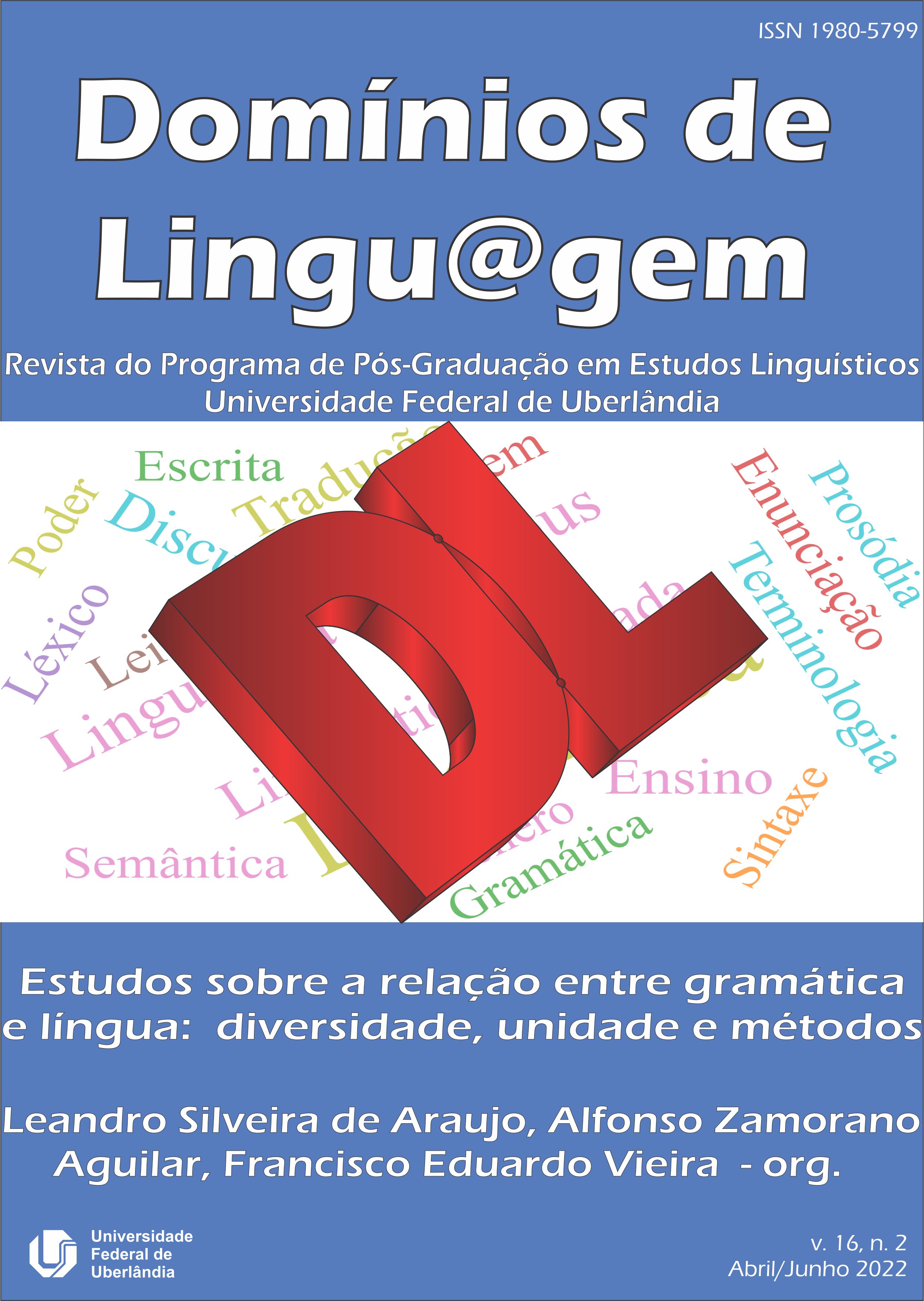The eternal regularity of participles
Uses and ideas about them in the current and 19th century mass media
DOI:
https://doi.org/10.14393/DL50-v16n2a2022-16Keywords:
Analogy, Participle, Press, Regularization, TwitterAbstract
This paper reviews, through the verb forms of participles, the phenomenon of analogy as an internal mechanism of language, the results of which are often of concern to speakers. The study is framed in the relationship between society and mass media nowadays and in the nineteenth century in the treatment of aspects of language, specifically, the uses and forms of participles. To this end, we have created a synchronic corpus of tweets in which doubts are posed to the RAE account on this issue and, in parallel, another diachronic corpus, from which we have selected four nineteenth-century press articles that focus on the morphology and correctness of a new verb formed analogically from a participle: presupuestar. The study concludes with the importance of the different platforms to satisfy the doubts of language users and shows the social interest aroused by the grammatical item we are investigating.
Downloads
Metrics
References
ÁLVAREZ, J. Tenemos siticias: el reanálisis y el falso corte. Delcastellano.com, Gramática histórica del castellano, 01/09/2013. Disponible en: https://www.delcastellano.com/reanalisis-falso-corte/.
ANÓNIMO. Otro ¿moro… o mono? en la palestra. El Avisador de Badajoz: semanario católico. Época II, año IV, n.º 165. Badajoz, 24/09/1885.
CALERO VAQUERA, M. L. Apuntes para una historia del léxico español: el Vocabulario de disparates… de Ana-Oller (1871)”. In: CALERO VAQUERA, M. L.; RIVERA, F. (coord.). Estudios lingüísticos y literarios in memoriam Eugenio Coseriu (1921-2002). Árbol académico, 2004. p. 51-64.
COSERIU, E. Introducción a la lingüística. Madrid: Gredos, 1986 [1951].
COSERIU, E. Sincronía, diacronía e historia. El problema del cambio lingüístico. Madrid: Gredos, 1988 [1957].
COTS, J.; ARMENGOL, L.; ARNÓ, E.; IRÚN, M.; Y LLURDA, E. La conciencia lingüística en la enseñanza de lenguas. Barcelona: Graó, 2007.
DEL RÍO Y SAINZ, J. A. El correo de Cantabria. Periódico de noticias, literario y de anuncios. Época 2.ª, n.º 142. Santander, 15/06/1883.
DEMONTE BARRETO, V. Lengua estándar, norma y normas en la difusión actual de la lengua española. 2003. Disponible en: https://digital.csic.es/handle/10261/13074.
DONCEL Y ORDAZ, D. El eco del Tormes. Revista semanal científico-literaria. Año 1, n.º 17. Salamanca, 13/05/1885.
ECHENIQUE, M. T; MARTÍNEZ, M. J. Diacronía y gramática histórica de la lengua española. Valencia: Tirant Humanidades, 2013.
EZPELETA AGUILAR, F. Miguel Vallés y la didáctica de la lengua en la escuela turolense del XIX. Xiloca, 36, p. 147-178, 2008.
FUNDÉU RAE. Fundación del Español Urgente (en línea). Disponible en: https://www.fundeu.es/.
GARCÍA FOLGADO, M. J. Lengua y gramática en El Magisterio Español (1871-1880). Ideas lingüísticas y pedagógicas en la prensa de España y América del siglo XIX. Boletín de Filología, 56, vol. I, 2021.
GAVIÑO RODRÍGUEZ, V. La polémica lingüística como tipología discursiva en la prensa española del siglo XIX. Los discursos polémicos de Fernando Gómez de Salazar. Pragmalingüística, 29, en prensa.
GILI GAYA, S. Imitación y creación en el habla infantil. Madrid: Real Academia Española, 1961.
POCH OLIVÉ, D. El interés por el lenguaje en La España Moderna. In AMORES, M.; y FERRÚS, B. (ed.). La España Moderna (1889-1914). Aproximaciones literarias y lingüísticas a una revista cultural. Madrid: Iberoamericana, 2019. p. 117-137. DOI https://doi.org/10.31819/9783954877324-006
PONS RODRÍGUEZ, L. Este huevo ¿lo han frito o freído? Verne. El País, 05/06/2020. Disponible en: https://verne.elpais.com/verne/2020/06/04/articulo/1591262135_874311.html.
PONS RODRÍGUEZ, L. Preguntamos si tiene lógica el 'contestastes' de Mecano y contestamos que sí. Verne. El País, 31/03/2019. Disponible en: https://verne.elpais.com/verne/2019/03/31/articulo/1554048239_988586.html.
PUCHE LORENZO, M. A. El DRAE (1817-1852) a través de la prensa española. In: AZORÍN, D.; CLAVERÍA, G.; JIMÉNEZ, E. (ed.). El diccionario de la Academia y su tiempo: lexicografía, lengua y sociedad en la primera mitad del siglo XIX. ELUA, 2019, anexo V. p. 65-68. DOI https://doi.org/10.14198/ELUA2019.ANEXO5.04
RAE Y ASALE. Diccionario panhispánico de dudas. 2005. Disponible en: https://www.rae.es/dpd/.
RAE Y ASALE. Manual de la Nueva gramática de la lengua española. Madrid: Espasa, 2010.
ROMEU FERNÁNDEZ, J. Lo que el español esconde. Barcelona: Vox, 2017.
VALLÉS, M. La unión, periódico de primera enseñanza. Año VI, n.º 287. Teruel, 11/07/1883.
Published
How to Cite
Issue
Section
License
Copyright (c) 2022 Miguel Silvestre Llamas

This work is licensed under a Creative Commons Attribution-NonCommercial-NoDerivatives 4.0 International License.
Authors who publish in this journal agree to the following terms:
Authors retain the copyright and waiver the journal the right of first publication, with the work simultaneously licensed under the Creative Commons Attribution License (CC BY-NC-ND 4.0), allowing the sharing of work with authorship recognition and preventing its commercial use.
Authors are authorized to take additional contracts separately, for non-exclusive distribution of the version of the work published in this journal (publish in institutional repository or as a book chapter), with acknowledgment of authorship and initial publication in this journal.









